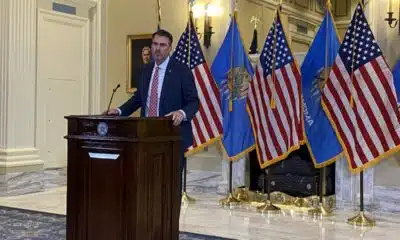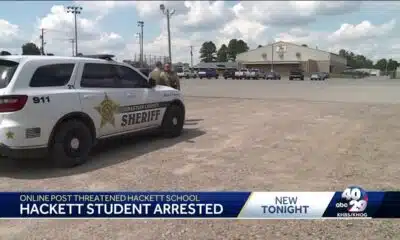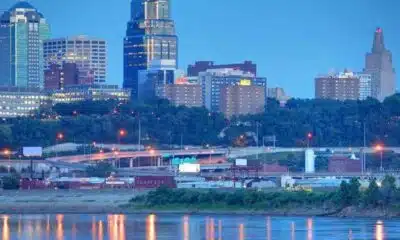News from the South - Texas News Feed
God, the Guadalupe and grief: Hill Country after the flood
“God and the Guadalupe long reigned over Texas Hill Country. Now grief permeates.” was first published by The Texas Tribune, a nonprofit, nonpartisan media organization that informs Texans — and engages with them — about public policy, politics, government and statewide issues.
Sign up for The Brief, The Texas Tribune’s daily newsletter that keeps readers up to speed on the most essential Texas news.
KERRVILLE — The storied Guadalupe River meanders through this Texas Hill Country town and into the unincorporated parts of Kerr County like a vein.
Sports bars, summer cabins and RV parks dotting its banks often feature the rugged and great Guadalupe’s name in banners and signs. For generations, Kerr County residents have gathered at the headwaters of the spring-fed river, which flows 260 miles out into the San Antonio Bay along the Gulf Coast.
Texans from all corners of the geographically diverse state flock here, too, for the Americana experiences of summer camp, tube floats and riverside getaways.
Clifton Fifer, a 72-year-old lifelong Kerrville resident, used to dip his feet in the water as a kid. When he got older, he would come out to fish.
“The river was our playground,” he said this week.
But in the pre-dawn darkness on July Fourth, the very river so core to the region’s identity betrayed residents and the countless vacationers who’d come to the Guadalupe for a long, leisurely holiday weekend celebrating America’s birthday. In less than an hour amid a torrent of rain, a 26-foot wall of water turned the river into a ferocious enemy that submerged homes, carried away vehicles, washed out roads and pulled hundreds of people into its unforgiving currents.
The full toll of one of the deadliest flash floods in Texas history continued to emerge in the week after the Guadalupe swelled. At least 120 people were killed. Thousands of recovery workers are still searching for at least 172 people still missing, though the likelihood of them being found alive dwindles every hour — and it’s been days since anyone was found alive.
Among the victims are 27 campers and counselors from Camp Mystic, itself a celebrated Texas icon. The devastation at the all-girls Christian camp garnered immediate global attention and compassion last weekend. But as officials released new counts in the days since and the number of people killed and still missing rose, it became starkly clear that the flood’s victims also include local residents who were at home, vacationers staying in rental cabins and people in RV parks all along the Guadalupe.
Today, one week after the disaster first began unfolding, miles of the river basin are filled with mangled metal and mountains of debris. Over the past seven days, Kerrville and the surrounding communities have hosted a cacophony of varied scenes as Texans desperately searched for missing loved ones, volunteers inundated the county, recovery workers meticulously combed miles of upheaval and locals tried to figure out how to move forward.
For many Texas families who have lived or vacationed here for generations, grief requires enduring in the very place where the overwhelming loss overbearingly lingers.
The people in Kerr County are deeply religious. Faith has emerged as a source of comfort and a way to embrace each other. As they rebuild, residents are also reexamining what it means to live alongside the river, finding ways to honor what was lost while searching for a path forward.
For some, this isn’t the first time. After all, this is part of “Flash Flood Alley.” The region’s dramatic elevation changes and non-absorbent soil conspire to send water rushing downhill fast when heavy rain storms hit. Still, many said the July 4 flood is the worst they’ve seen in their lifetime.
At around 3 a.m. on July 4, the river’s currents first tore through Camp Mystic and the surrounding neighborhoods in Hunt, an unincorporated town that sits at the upper tributary of the Guadalupe River. Most houses there, residents said, sit roughly 40 feet above the river.
/https://static.texastribune.org/media/files/1f5d390898cafae44d335cf3e5de5b04/0709%20Ground%20Zero%20RB%20TT%2023.jpg)
On Wednesday afternoon, James Wright and his son were among families in Hunt scavenging for any salvageable items in their homes. Trucks pulled in and out of the houses, hauling branches and furniture. The only sounds from a distance were airborne drones, an endless stream of trucks cramped in the two-lane road and a recovery worker manning a whirring saw.
Wright, 69, has owned his home in Hunt since 1990. He, his wife Donna, and their three sons live in San Antonio year-round but summer in Hunt.
While Wright and Donna slept, the river grew and ripped through the house. They woke up to water on the floor. They ran to the attic in a carport next to the house, where they waited out the flood for about two hours. At about 5:00 a.m., the couple walked to a nearby Methodist church.
On Wednesday, as Wright collected the paintings he inherited from his mother, he, like so many others, grappled with the truth that their beloved homes stand on unforgiving ground.
“We’re always prepared for a flood, to be stuck here for a couple of days without electricity. That’s just a contingency of living on the river,” he said. “But none of us ever thought the water was going to get in these houses.”
Salvaging what’s left
Nancy Allery’s family also owns a home in Hunt. The Houston native wasn’t there when the home, like Wright’s next door, flooded. But her sister, brother-in-law and niece were there when the deadly currents hit. Richard Zdunkewicz, her brother-in-law, was the first to wake up to the sound of the raging river at 3 a.m. He told his wife, Catherine Zdunkewicz, and his daughter, Nancy Zdunkewicz, to get in the car. But the river grew so fast that they were scared to drive further than the fence. So the three climbed up the trees. The water reached Richard’s knees and Catherine’s ankles. Nancy kept looking at her mom to make sure she still clung to the trunk, she said.
They held on for two hours until the water receded and the street became walkable again. Two women they did not know picked them up on the side of the road and drove them to the Methodist church, where Nancy’s brother picked them up.
“There was no way of understanding how quickly the water was going to go up,” Nancy Zdunkewicz said. “It was just this bubbling, violent, dark river, and then you could just tell you did not want to be at the point where water from the road was meeting the river, swirling.”
/https://static.texastribune.org/media/files/828e134aa99ec485cddb035039a2c4a3/0709%20Ground%20Zero%20RB%20TT%2001.jpg)
Nancy and her mom, both of whom went to Camp Mystic as children, said it was hard for them to think about the campers the night the area flooded.
“If you went to Mystic and you were in those cabins, you think about how young you were. It was black outside, it was pitch black, and how scary it would be to be dealing with that in those waters at that age.”
Allery said the county should invest in sirens to alert people along the river of a crisis. Local, state and federal officials have faced a barrage of questions and criticism about the lack of warning ahead of the floods. The National Weather Service sent out its first flash flood warning for part of Kerr County three hours and 21 minutes before the first flooding reports came in, creating a window to warn people along the banks. Amid conversation about a flood warning system before the flood, Kerr County officials have been caught between a desire to make the region safer and constituents’ demands to reduce property taxes and government waste.
Texas lawmakers will consider better warning systems during a special legislative session that begins July 21. On Thursday, the Texas Senate and House formed special committees to consider stronger disaster preparedness and flooding laws.
Allery doesn’t know if she wants to be in Hunt for the next flood. The home and some of the items she recovered on Wednesday had been in the family for 30 years, she said. Her family has had ties to the area for almost a century. For decades, she watched campers laugh and run around the field and along the river. But now, Allery said, the family doesn’t know whether they should keep the home.
Her husband, Darrell Bowling, thinks they’ll keep it.
“Did you hear my wife talk about this place, the connection to this place?” he asked. “Her connection to this place is in our hearts and the spirit of who she is, and that’s the same for the people here. That’s what this place is about, and it’s how we’ll survive.”
Amid staggering loss, a prayer
Kerr County has about 55,000 residents and more congregations than grocery stores. Kerrville is the county seat. And in these towns and enclaves, Christianity is just as important to many as the river.
“It is part of the culture of Kerrville,” said Josh Smithson, who led a sermon at the vigil commemorating the dead and missing this week.
During his sermon, kids as young as 8 or 9 years old recited the Bible verses back from their memory with their eyes closed.
“People are seeking comfort in that,” Smithson said.
The county’s churches were early response hubs, for worship and for aid efforts. At Riverside Church of Christ, minister Chris Carrillo tried to help the best he could. As soon as members of his congregation filtered out of the pews after his Sunday service, he started to sort through and deliver bucketloads of supplies, many of which were donations from across the country.
/https://static.texastribune.org/media/files/24dd9fe625a749440f10d2af8809fcb2/0706%20Kerrville%20Day%202%20BB%20TT%2003.jpg)
Lois Shaw, 84, lost two longtime friends in the floods, including Camp Mystic director Richard “Dick” Eastland, who died trying to save the lives of his campers.
“It has pulled me down. To see all that devastation, to see so many families separated,” Shaw said. “I’ve been asking God to give me strength because others need me. And I want to be there.”
Shaw works at the Doyle Community Center as a facilities manager. All week at work, she’s listened to the gospel station Keeping Him Close By.
Shaw lived through the floods of 1987, where a bus of kids trying to evacuate did not survive. She is still hurting from that, and now she is hurting again. She doesn’t know if the hurt will ever stop.
When asked about current recovery efforts, she paused and offered a quiet smile.
“I’m trying to practice prayerful thinking,” Shaw said.
Out near Hunt, the law enforcement and ambulance sirens came and went Wednesday on Junction Highway, the road to the western part of the county, where most of the bodies have been recovered. The sirens are an unrelenting reminder of how many families continue to wait for their children and parents and grandparents to be found.
Near the road, Donna Ragsdale held a sign that said, “PRAYING.”
Ragsdale, who teaches at Ingram Tom Moore High School, stood in the sun with her sign to show support for recovery workers.
“We all need prayers,” said Ragsdale, who has been crying in church these days. “I know God is going to take care of us.”
Grief at every turn
Randi Webber, 38, looked out onto the Tivy High School football field after the Wednesday night vigil. As a student 20 years ago, she cheered on those very sidelines. Every few minutes, a friend came up, outstretched their arms and asked if she was doing OK.
Is she? Is anyone? In a town as small as Kerrville, everyone is tied to one another. So loss doesn’t stay in one household. It spreads, through classrooms, through church, at the store.
One of her closest friends took his wife and two sons camping in an RV in nearby Ingram for the holiday weekend. Their daughter was staying at a nearby camp.
The four family members who were camping were swept away. In the days after the storm, Webber went out to the Guadalupe — the same river where she had played and prayed and learned her whole life — to look for them. Webber’s friend and his wife are now among those confirmed dead. Their two boys are among the 172 still missing. Their daughter is now the sole survivor of the family.
The friend’s wife had just been declared free of cancer.
The family members who died or are still missing are among an unknown number of victims drawn to the river for a holiday weekend. Just as the Guadalupe is lined with summer camps for kids, it also has recreational campgrounds and RV parks that draw tourists.
In nearby Ingram, at least 26 people staying at the HTR Campground overlooking the river were swept away, according to the Kerr County Lead. On the morning of the flood, Ingram City Council member Raymond Howard, who lives in a single-family home on the same block as the campground, saw an RV with its interior lights on drifting down the otherwise pitch-black Guadalupe.
“I could see three or four people, maybe five people, in that camper, screaming for help,” Howard said.
/https://static.texastribune.org/media/files/7643adb2bc497d3656950849319e4a2c/0709%20Kerrville%20Vigil%20RB%20TT%2010.JPG)
Webber’s been left searching for a new normal. Usually, she’d reach out to her friend, who worked at a local funeral home and is now among the dead. He always knew what to say. He always had a way of making things make sense.
She’s struggling to help guide her own children through the personal loss — and the staggering collective grief wrought by the river they know so well.
Webber has found herself looking back at old text exchanges with the friend she lost — especially messages he sent her as solace when her own father died.
She won’t be keeping those conversations to herself forever.
“What he said about dads and daughters, that’s exactly what I’m going to tell his daughter,” said Webber. “He just laid it all out.”
At bedtime Tuesday, Webber’s 11-year-old son folded his hands to pray.
“Dear Lord,” she recalled him saying, “thank you for today and all the blessings you have given us … like the bodies, even though they are …”
His voice trembled.
“…gone. We have their spirit. Like you. And thank you for the reconstruction and all the workers. And let us come together. In Jesus’ name we pray, amen.”
This article originally appeared in The Texas Tribune at https://www.texastribune.org/2025/07/11/texas-floods-guadalupe-kerr-county-survivors-victims-rebuild/.
The Texas Tribune is a member-supported, nonpartisan newsroom informing and engaging Texans on state politics and policy. Learn more at texastribune.org.
The post God, the Guadalupe and grief: Hill Country after the flood appeared first on feeds.texastribune.org
Note: The following A.I. based commentary is not part of the original article, reproduced above, but is offered in the hopes that it will promote greater media literacy and critical thinking, by making any potential bias more visible to the reader –Staff Editor.
Political Bias Rating: Centrist
This content is a straightforward, human-focused news report centered on the impact of a natural disaster in a Texas community. It emphasizes personal stories, community resilience, and local responses without engaging in partisan commentary or policy debates. The narrative neither advocates for particular political ideologies nor critiques specific political actors. It remains neutral and fact-based, prioritizing empathy and human interest over political framing, which characterizes a centrist approach.
News from the South - Texas News Feed
By the numbers: Stats to know about the Texas Longhorns' 2025 season
SUMMARY: The Texas Longhorns football team is off to a 0-1 start this season, with no SEC games played yet. They average 7 points scored and 14 points allowed per game. Offensively, the team performs best in the fourth quarter, scoring all their points then, while defensively, they allow most points in the second and fourth quarters. The Longhorns rank No. 7 in the AP poll and No. 6 in the Coaches Poll. They trail opponents 65% of the game time, convert 26% of third downs and 17% of fourth downs, and have lost 50 yards to penalties. The highest attendance at DKR was 105,215 during the 2024 Texas-Georgia game.
The post By the numbers: Stats to know about the Texas Longhorns' 2025 season appeared first on www.kxan.com
News from the South - Texas News Feed
YouTube vigilantes help feds bust $65M scam ring targeting seniors
SUMMARY: Federal prosecutors in San Diego dismantled a $65 million international fraud ring targeting elderly Americans, aided by YouTube “scambaiters.” The 28 indicted members, mostly Chinese nationals, collaborated with India-based call centers using fake tech support and psychological tactics to steal money. Victims were tricked into returning supposed “extra” refunds via wire transfers, gift cards, or cash. Agencies including Homeland Security, FBI, and IRS arrested suspects across several states and seized over $4 million in assets. YouTubers from Scammer Payback and Trilogy Media helped identify key defendants by baiting scammers and exposing their operations, highlighting innovative law enforcement collaboration.
Read the full article
The post YouTube vigilantes help feds bust $65M scam ring targeting seniors appeared first on www.kxan.com
News from the South - Texas News Feed
Texas counties replace voting machines after Trump order
“Some Texas counties replace touchscreen voting machines after Trump order” was first published by The Texas Tribune, a nonprofit, nonpartisan media organization that informs Texans — and engages with them — about public policy, politics, government and statewide issues.
Sign up for The Brief, The Texas Tribune’s daily newsletter that keeps readers up to speed on the most essential Texas news.
This coverage is made possible through Votebeat, a nonpartisan news organization covering local election administration and voting access. Sign up for Votebeat Texas’ free newsletters here.
After years of using a touchscreen machine to mark their ballots, voters in at least three Texas counties will be asked instead to make their selections directly on the paper ballots, by hand, starting in November.
Election officials in Collin, Williamson, and Bastrop counties said they’re proactively changing their voting procedures and equipment in response to an executive order from President Donald Trump in March that sought to mostly ban voting equipment that uses barcodes or QR codes on paper ballots to speed up vote counting.
Some other provisions in the executive order have been blocked by the courts, but this one has not. The order instructed the U.S. Election Assistance Commission, which crafts the certification guidelines that most states rely on for their voting equipment, to amend the guidelines to prohibit such systems and “take appropriate action” to review and rescind previously issued certifications based on prior standards.
U.S. EAC Commissioner Donald Palmer told state election directors at a July conference that “there won’t be mass decertification of systems” in the near future. Still, Trump’s order has sparked questions from the public and uncertainty about the use of different kinds of voting machines.
Election officials have concerns, too, about the potential cost and complexity of having to switch voting systems. Some Texas counties, and officials in states including Ohio, California, and West Virginia, are opting to make changes now, in a year without a federal election, hoping to prevent disruption closer to the 2026 midterms.
“Every election is important, but you would never want to try such a big change for a primary election,” said Kaleb Breaux, election administrator in Collin County, north of Dallas, which is spending $2.3 million on the switch. “You want it to be a known process that your voters and people in your county trust.”
His department is planning to host events next month to give voters a chance to familiarize themselves with new equipment.
Touchscreen voting machines, barcodes and the Trump order
In most Texas counties — including the most populous — voters make their selections on touchscreen machines known as ballot-marking devices. At check-in, they receive a blank paper ballot that is inserted into the ballot marking device. Once a voter makes their selections on screen, the machine prints them out on the ballot for the voter to review. Then the voter inserts the ballot into the tabulation machine to be counted.
The counties potentially affected by Trump’s executive order use ballot-marking devices made by Elections Systems & Software, one of two state-certified voting system vendors. In addition to marking the ballots with the voter’s choices, the ES&S equipment prints a machine-readable code reflecting those choices that is used to speed up tabulation.
Critics of such systems have argued for years that voters have no way of knowing whether the code accurately reflects their choices, even though the results are audited.
ES&S told Votebeat that it is developing new equipment to meet the latest iteration of federal guidelines, and that it won’t use codes. Equipment from Hart Intercivic, the other state-certified vendor, doesn’t use machine-readable codes.
Both vendors also give counties the option of using paper ballots that voters mark by hand. Those systems still use tabulator machines to scan the ballots and count the votes.
Last month, Texas Elections Director Christina Adkins told a group of election officials that she’s waiting to see what action the federal EAC takes on certification of voting equipment in response to Trump’s executive order. Any change to the Voluntary Voting System Guidelines would immediately affect Texas’ certified voting systems, which must follow the federal guidelines under state law.
Adkins said voters across the state have been speaking at public meetings and have asked legislators about the part of the president’s executive order on machine-readable codes and paper ballots. She asked election officials to be prepared to answer questions from voters in their communities with accurate information about the order and how the state plans to respond.
Meanwhile, a Republican-led push to ditch all electronic voting equipment — including the tabulators — and hand count ballots instead, has made inroads in Texas. Gillespie County in the Texas Hill Country hand-counted thousands of ballots in the 2024 primary, but had to fix a series of errors in the results, which couldn’t easily be audited for accuracy because the ballots couldn’t be scanned by machines.
Different methods of voting in Texas
About 80% of Texas’ 254 counties use machines to mark voters’ choices on paper ballots. In the rest, including Denton County in North Texas and Cameron County in South Texas, voters mark the paper ballots by hand, and then put them in the tabulator for counting. (Even these counties must make at least one electronic voting machine available in each voting location to comply with the Americans with Disabilities Act.) .
Two small Texas counties — Limestone and Foard — don’t use paper ballots at all, but state law will require them to by next year.
Paper ballots, whether marked by a hand or a machine, are typically considered the gold standard for election security. They allow voters to check their selections before casting their ballot, and create a physical record for audits and recounts.
But is one way of marking ballots better than the other? Some election officials say that with hand-marked ballots, it’s harder to determine voter intent if there’s a doubt, or for a scanner to read the voter’s selections. On the other hand, some say hand-marked ballots allow voters to check for errors right away, rather than having to wait until they’re done voting and their ballot is printed out. And lines can move faster if people don’t have to wait for a machine.
Collin County prepares for the changes
In Collin County, a Republican-led community with 750,000 registered voters, the switch away from ballot-marking devices follows years of lobbying by activists urging the commissioner court to eliminate voting machines, even though the system has gotten high marks from the Texas Secretary of State’s Office.
A measure to make the change failed last year, but county officials approved a new one in June.
Trump’s executive order “was a bit of a catalyst for the court to revisit this move,” said Kaleb Breaux, the Collin County elections director.
As a result, 1,500 ballot-marking devices, which the county has used since 2019, will be put in storage. The county will still use about 300 of them at polling locations to comply with federal law on disability access. Trump’s executive order allows leeway for that, as long as the machines produce a voter-verifiable paper record.
The $2.3 million the county is spending includes the purchase of voting booths, printers, laptops, and other election materials. Breaux said the voting booths take up less space than the voting machines, so polling locations can accommodate more voters than before.
However, he wants to encourage voters to take their time marking their ballots in November to avoid problems tallying later. “Make sure they’re bubbling everything in completely,” he said. “And if they mess up their ballot, don’t be afraid to ask for another one.”.
Breaux said he hopes the new method of voting can help boost voter trust.
“I think what we had worked well,” he said, “but I also think this is going to work just as well for our voters and our workers.”
Natalia Contreras is a reporter for Votebeat in partnership with the Texas Tribune. She is based in Corpus Christi. Contact Natalia at ncontreras@votebeat.org
More all-star speakers confirmed for The Texas Tribune Festival, Nov. 13–15! This year’s lineup just got even more exciting with the addition of State Rep. Caroline Fairly, R-Amarillo; former United States Attorney General Eric Holder; Abby Phillip, anchor of “CNN NewsNight”; Aaron Reitz, 2026 Republican candidate for Texas Attorney General; and State Rep. James Talarico, D-Austin. Get your tickets today!
TribFest 2025 is presented by JPMorganChase.
This article originally appeared in The Texas Tribune at https://www.texastribune.org/2025/09/02/trump-election-executive-order-texas-voting-machines/.
The Texas Tribune is a member-supported, nonpartisan newsroom informing and engaging Texans on state politics and policy. Learn more at texastribune.org.
The post Texas counties replace voting machines after Trump order appeared first on feeds.texastribune.org
Note: The following A.I. based commentary is not part of the original article, reproduced above, but is offered in the hopes that it will promote greater media literacy and critical thinking, by making any potential bias more visible to the reader –Staff Editor.
Political Bias Rating: Centrist
This content presents a balanced and factual report on changes in voting procedures in Texas counties prompted by a Trump executive order. It includes perspectives from election officials, relevant legal context, and both criticisms and defenses of touchscreen voting machines without promoting a partisan viewpoint. The language is neutral and focuses on informing readers about the logistical and regulatory aspects of election equipment changes, reflecting a centrist approach to political news coverage.
-
Mississippi Today3 days ago
DEI, campus culture wars spark early battle between likely GOP rivals for governor in Mississippi
-
Mississippi Today7 days ago
Judge: Felony disenfranchisement a factor in ruling on Mississippi Supreme Court districts
-
News from the South - North Carolina News Feed6 days ago
Parasocial party: Why people are excited for the Taylor Swift, Travis Kelce engagement
-
News from the South - Louisiana News Feed6 days ago
K+20: Katrina alters local health care landscape, though underlying ills still the same
-
Our Mississippi Home6 days ago
The Great Backyard Recovery – Helping Birds After the Storm
-
Local News5 days ago
Police say Minneapolis church shooter was filled with hatred and admired mass killers
-
The Center Square7 days ago
U-M Health ends transgender treatment for minors | Michigan
-
Local News Video4 days ago
08/29 Ryan's “Wet End to the Week” Friday Forecast











































